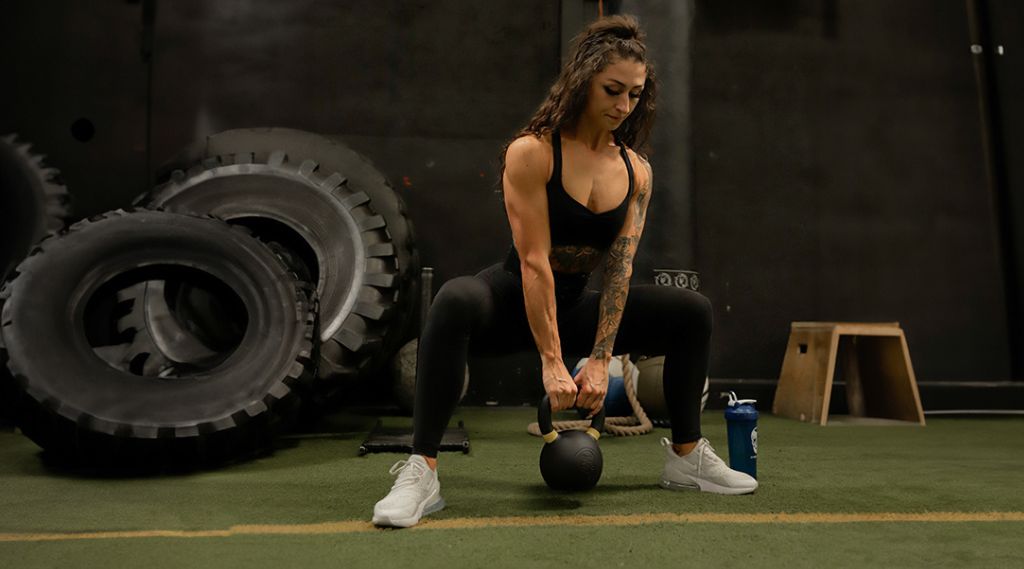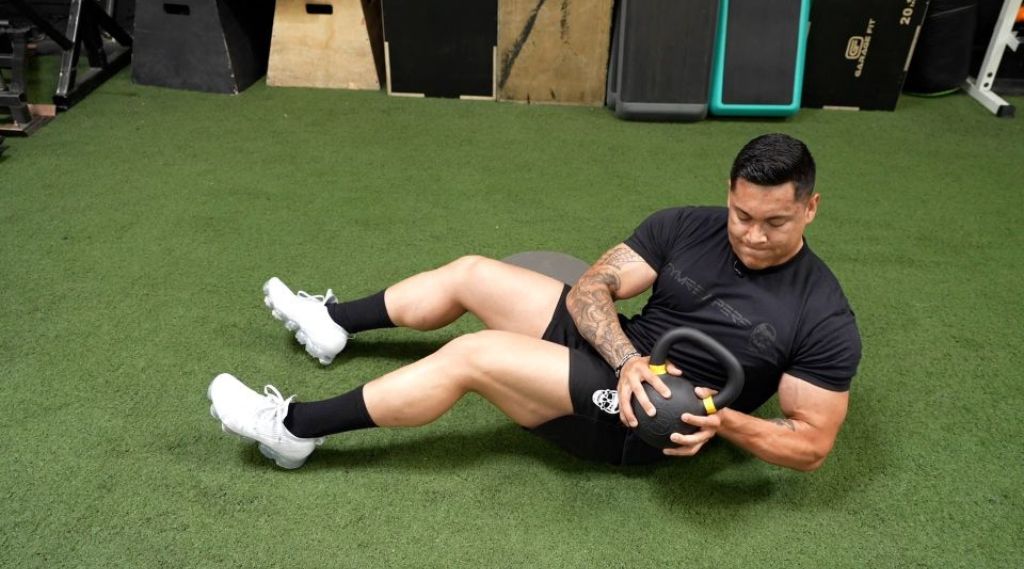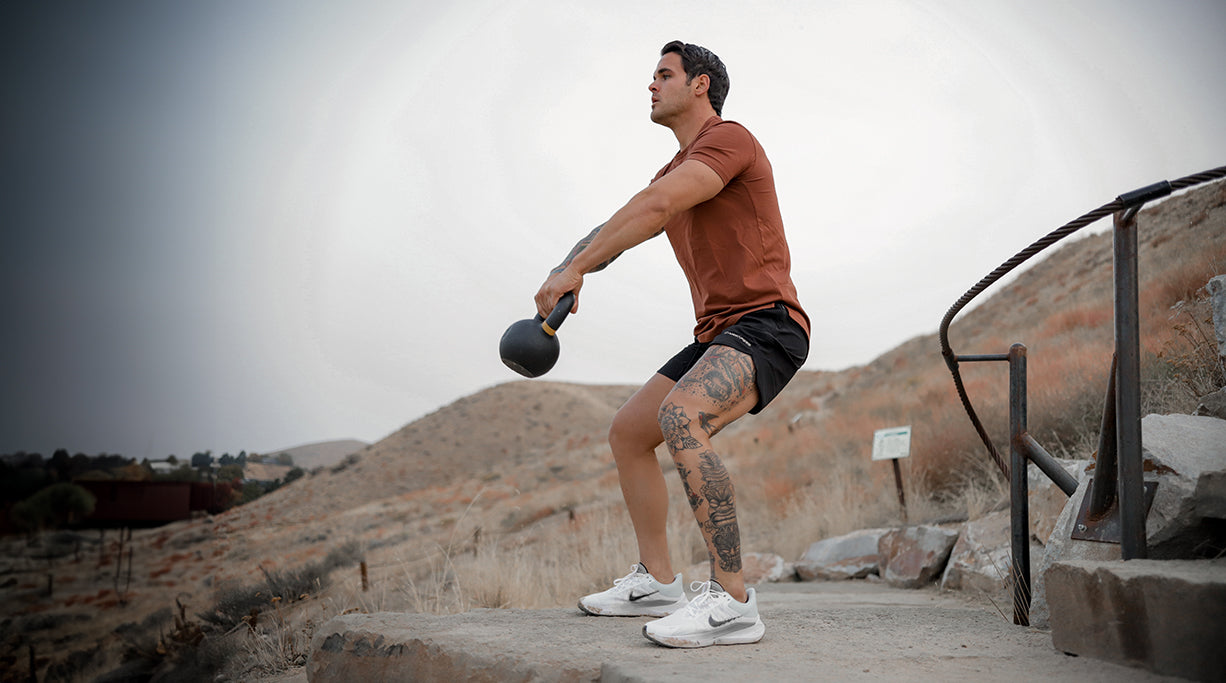As a personal trainer, I use the kettlebell deadlift on a daily basis to teach clients how to master deadlifting mechanics before progressing to barbell and trap bar deadlifts.
Kettlebell deadlifts are beneficial because they train multiple muscle groups, build full body strength, are more accessible and beginner-friendly, and allow for progression over time. They can also be performed unilaterally (gripping the weight with one hand) to prevent muscle imbalances.
To help you reap the benefits of the kettlebell deadlift, I’ll teach you exactly which muscles it works and how to do it properly. I’ll also explain some common mistakes that you should avoid to keep yourself injury-free.
Key Takeaways
Kettlebell Deadlift: Anatomy Overview

The kettlebell deadlift is an effective whole-body exercise. Here is a closer look at the muscles it trains and their functions:
Gluteus Maximus
The gluteus maximus is the largest and most powerful muscle group in the body. Their primary function is hip extension, which occurs when the hip joint opens up and the angle between the upper and lower body increases.
Your glutes play an essential role during kettlebell deadlifts as they contract to drive the hips forward, allowing you to move from a bent-over to a standing position.
Hamstrings
The hamstrings make up the back portion of the thighs, and their primary role is assisting the gluteus maximus with hip extension.
Strong hamstrings can also promote knee and hip stability, which is vital during activities like deadlifts, as well as more dynamic movements like the kettlebell swing.
Quadriceps
The quads make up the front portion of the thighs, and their primary function is knee extension (straightening of the legs). The quads initiate the movement off the floor and work to straighten your legs as you drive your hips forward. They also assist the hamstrings in promoting knee stability.
Erector Spinae
The erector spinae is a group of muscles that run along both sides of the spine. Their primary function is to extend the back and keep it in a healthy, neutral position during exercise.
These muscles are heavily involved during kettlebell deadlifts because they must work hard to resist spinal flexion (rounding).
Midsection (Core)
The rectus abdominis, transverse abdominis, obliques, and other midsection muscles must flex isometrically (contract without changing position) to support the torso during the kettlebell deadlift.
These muscles work as stabilizers, providing the stability needed to move the kettlebell safely through the entire range of motion.
Latissimus Dorsi
The latissimus dorsi, also known as the ‘lats,’ are the largest muscles in the upper body and make up a significant percentage of the mid and upper back.
These muscles contribute to a stable torso position, keeping the kettlebell close to the body during the pull. When the lats do their job properly, there is much less risk of spinal flexion and trainees can lift the weight more efficiently in a straight line.
Trapezius
The trapezius makes up the upper back, and one of its primary roles is stabilizing the scapulae (shoulder blades).
Your traps play an essential role during kettlebell deadlifts as the muscle promotes shoulder stability and reduces the risk of excessive upper back rounding during the pull.
Benefits Of Deadlifts With A Kettlebell

The benefits of performing deadlifts with a kettlebell include:
More Accessible and Convenient
Barbell and trap bar deadlifts might not always be an option for trainees because these require special equipment.
For example, folks working out at home must purchase a barbell (or trap bar), enough weight plates for proper loading, and barbell clips. They would also need enough space at home to store and use all that equipment.
In contrast, kettlebells are far more affordable and don’t take up as much space. Plus, even at the gym, these weights are typically plentiful and not in use, so nobody is going to ask, “How many sets have you got left?”
Good For Grip Strength
The traditional kettlebell handle is thicker than a barbell, making it more difficult to grip for extended periods. That extra challenge can translate to stronger hands, forearms, and grip, which is highly beneficial for various gym and everyday activities.
Great for Unilateral Training
Kettlebells are ideal for unilateral training, where the goal is to work one side of the body at a time. In addition to building core strength, unilateral training addresses side-to-side muscle imbalances.
Great Overloading Potential
While it’s impossible to deadlift 300, 400, or even 500+ lbs when using a kettlebell, that doesn’t mean you cannot overload your muscles and build strength for a long time.
One option is to use a progressively heavier kettlebell. For example, the Gymreapers kettlebells range from 4 to 40 kilograms (9 to 88 lbs), which means beginners can gradually increase the load for months if not years.
Another option is to grip the kettlebell with one hand at a time. Doing so would instantly make the exercise twice as challenging and train one side at a time. This is ideal when you’re limited by the amount of weight you have access to.
You can also experiment with tempo, rep ranges, and intensity techniques (e.g., drop sets) to provide a new stimulus and keep progressing over time.
Possibly Improved Proprioception
Proprioception refers to awareness of one’s body and how it moves through space. Any deadlift variation will positively affect proprioception because these exercises are complex and require a lot of focus to execute correctly.
Performing the deadlift with a kettlebell could be even more beneficial because the goal is to hold the weight with one hand. Unlike a barbell deadlift, where the weight is spread evenly between both sides of the body, holding a kettlebell with one hand allows trainees to focus on one side.
The lack of stability forces lifters to be more aware during each set and pay closer attention to the position of their knees, hips, spine, and shoulders.
How To Do A Kettlebell Deadlift
To perform a kettlebell deadlift properly, follow these steps:
-
Position a kettlebell between your feet.
-
Have your feet hip-width apart or slightly wider with your toes pointing forward and out.
-
Bend your knees and lean your torso forward to reach the kettlebell.
-
Grab the kettlebell handle with both hands, keeping your arms straight.
-
Puff your chest out to straighten your back.
-
Take a deep breath and engage your abs.
-
Push the floor away with your legs as you pull the kettlebell in a straight line.
-
Simultaneously extend your knees and hips to stand up.
-
Squeeze your glutes at the top to bring your hips underneath you without hyperextending your lower back.
-
Pause briefly and lower the kettlebell to the floor in the same straight line by pushing your buttocks back and slowly bending your knees.
- Exhale as you reach the bottom and prepare for the next repetition.
5 Common Mistakes With Kettlebell Deadlifts & How To Fix Them

To maximize your kettlebell deadlifts and reduce your risk of injury, watch out for these common mistakes that lifters typically make.
Mistake #1: Rounding the Lower Back
Back rounding, also known as spinal flexion, is one of the most common deadlift mistakes. It typically happens as a result of improper positioning due to a lack of body awareness; however, it can also happen if you’re attempting to lift more weight than you can handle.
The problem with back rounding is that it can place significant stress on the spine and eventually result in an injury.
How To Fix
Prioritize proper form above all else. Ensure that your starting position is good and your back is in a healthy, neutral position. Ensure your is puffed out and your lats are engaged as this will help you achieve a neutral spine.
I highly recommend filming some of your sets from the side to see if your back rounds at any point.
Mistake #2: Lifting With Your Back
This might not seem like a mistake because deadlifts are a back exercise. However, that subtle error can affect your performance and increase the risk of back rounding as you get tired.
The problem results from the hips being too high and the torso being too horizontal in the bottom position. That setup forces trainees to engage their back more than their glutes and hamstrings, turning the kettlebell deadlift into a stiff-leg deadlift that puts more stress on the erectors than they may be able to handle.
How To Fix
Set yourself up correctly at the bottom by puffing your chest out and lowering your hips. You should also be able to feel your legs initiating the movement off the floor.
If you’re videoing your sets then watch it back and ensure your hips are below your shoulders in the start position.
Mistake #3: Having the Kettlebell too Far Forward
Deadlifts are about efficiency. A strong and safe deadlift follows one fundamental rule: lifting and lowering the weight in a straight line.
Having the kettlebell too far forward throws a wrench in that fundamental requirement, making the movement less efficient and increasing the risk of losing your balance or allowing your spine to flex under load.
How To Fix
Position the kettlebell between your feet at the start of the set. The kettlebell should roughly align with the middle of your feet when you look at it from the top. That way, the weight will remain within your center of gravity, allowing you to lift more and maintain your balance.
Additionally, focus on keeping your lats engaged to keep the kettlebell close to your body as you stand up and lower back down. The closer the kettlebell is to your body, the more weight you’ll be able to lift and the safer it will be.
Mistake #4: Hyperextending or Not Extending Enough
Hyperextension or a lack of full hip extension at the top position are common and somewhat similar mistakes, so we are discussing them together.
Hyperextension happens when you drive the hips too far forward and it causes the lower back to arch at the top position. It places more stress on your spine and increases the risk of injury.
In contrast, not extending your hips enough at the top of the movement would prevent you from engaging your posterior chain (i.e. glutes & hamstrings) as much as possible, making each repetition less effective and placing more stress on other supporting structures.
How To Fix
Extend your hips at the top of each repetition by squeezing your glutes and keeping the core engaged. Ensure your glutes are stacked underneath your shoulders. When viewed from the side, your body should be in a straight line.
Mistake #5: Squatting the Weight Up
In contrast to lifting with your back, squatting the weight up is a mistake that causes the quads to do more work than the posterior chain.
Trainees often squat the movement because they set up with their hips too low in the start position, which causes the quads to perform more of the movement rather than the glutes and hamstrings.
How To Fix
Get used to setting up so your hips are high enough that you feel the tension in your glutes and hamstrings but not so high that they are in line with your shoulders (mistake #2).
Your quads should initiate the movement from the floor, but you should feel your hamstrings and glutes working after that. If you don’t, then be sure to video your lift to see if your hips are set correctly in the start position.
Best Kettlebells For Deadlifts

For starters, you can pick from multiple weight options to suit your needs. Start with the 4-kilo kettlebell if you’re new to resistance exercise, and gradually work up to 40 kilograms as you get stronger.
Secondly, the handle is smooth, which allows for a comfortable grip, less friction, and fewer calluses. The handles of these kettlebells are also thicker than a traditional barbell, which can promote grip strength.
To top it off, these kettlebells look great and come with kilogram and pound imprints, allowing you to see how much weight you’ve picked up so you can track your progress over time.













Leave a comment
All comments are moderated before being published.
This site is protected by hCaptcha and the hCaptcha Privacy Policy and Terms of Service apply.